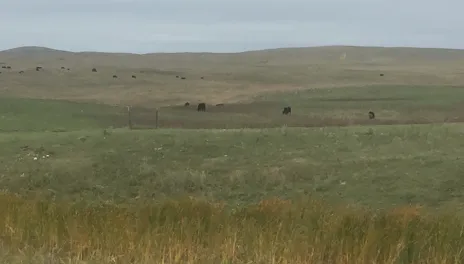Fall Pasture Weed Control
Good day to you!
We received rainfall up to at least 2.7 inches over the weekend. That is the most rain since I have been here. Temperatures were above normal again last week.
Corn silage, soybean, and dry bean harvest is nearly complete and sunflower and corn grain harvest has a few acres done already. The corn has dried drastically in the past week. Soybean yields have been across the board from 15 to 35 bushels per acre. Corn yields so far have been from 65 to 150 bushels per acre
Now is still a good time to control biennial and cool-season perennial weeds in pastures and rangeland, although the time is narrowing based upon the current forecast. Cool-season weeds include leafy spurge, field bindweed, Canada thistle, the knapweeds, absinth wormwood and others.
To control field bindweed, apply Tordon 22K plus 2,4-D or Facet L plus Overdrive plus methylated seed oil.
To control diffuse and spotted knapweed and yellow starthistle apply dicamba plus nonionic surfactant, Tordon 22K, Tordon 22K plus 2,4-D ester, Plateau, or Milestone. Plants in the rosette stage will be controlled most effectively.
Milestone can be applied as a spot treatment up to 14 fluid ounces per acre to dormant Russian knapweed plants for control. Apply Plateau or Tordon 22K after several hard freezes around mid-October. Plants may be dormant with a grey stem and no leaves and still be effective. For control, Plateau must be applied at 12 fluid ounces per acre which will reduce grass production, so spot treatments are best.
The most cost-effective treatment to control leafy spurge in pastures and rangeland is Tordon 22K at 2 pint per acre plus 2,4-D ester at 2 pints per acre. For best control of leafy spurge, plants need to be between 4 and 12 inches in height. Other treatments providing some control of leafy spurge include dicamba at high rates plus oil adjuvants or Facet L plus Overdrive plus a methylated seed oil adjuvant. Casoron 4 G or Norosac 10G can be applied in late November to early March before emergence for season long suppression.
To control Canada thistle apply Curtail, Stinger or Transline plus oil adjuvant, Overdrive plus a methylated seed oil adjuvant, chlorsulfuron plus metsulfuron plus an oil adjuvant, or Milestone. Milestone is more effective in the fall than the spring.
To control bull, musk, or plumeless thistle apply 2,4-D, 2,4-D plus dicamba plus an oil adjuvant, chlorsulfuron plus metsulfuron plus an oil adjuvant, dicamba, Overdrive, Curtail, Milestone, Transline, or Tordon 22K. Fall is the best time to control biennial weeds.
For control of dalmation toadflax apply Plateau at 12 fluid ounces per acre plus a methylated seed oil adjuvant after a hard freeze when 25 percent of foliage is necrotic.
To control absinth wormwood, hopefully you mowed the plants in mid-summer and allowed them to grow at least 12 inches before application this fall. Herbicides that can provide effective control if plants are mowed and 12 inches tall include 2,4-D, dicamba plus an oil adjuvant, Curtail, Tordon 22K, and Milestone.
For herbicide rates and more information consult pages 64 to 78 in the 2021 North Dakota Weed Control Guide and herbicide labels for grazing restrictions and other information.
